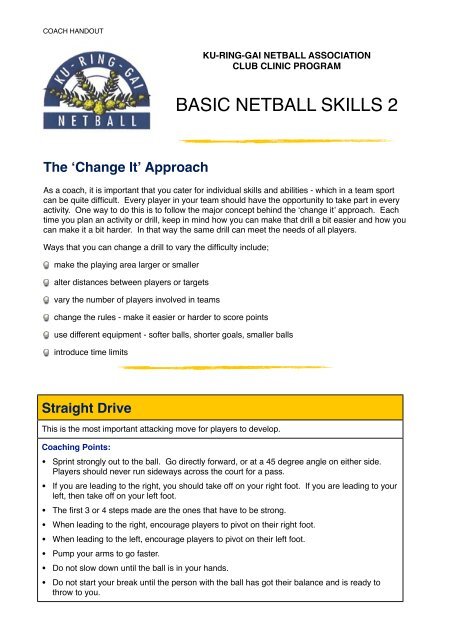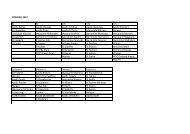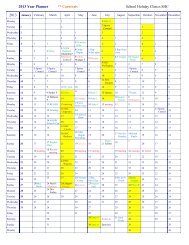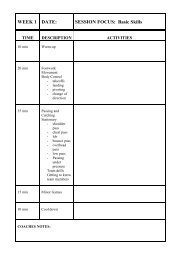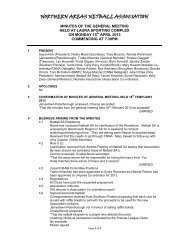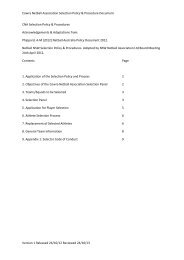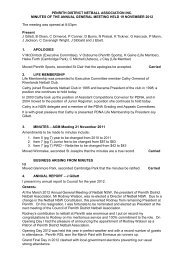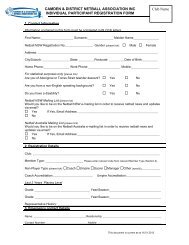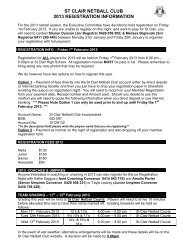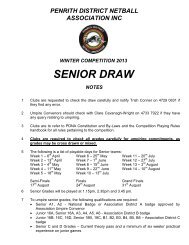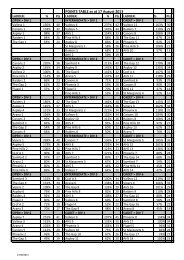Create successful ePaper yourself
Turn your PDF publications into a flip-book with our unique Google optimized e-Paper software.
COACH HANDOUT<br />
KU-RING-GAI NETBALL ASSOCIATION<br />
CLUB CLINIC PROGRAM<br />
BASIC NETBALL SKILLS 2<br />
The ʻChange Itʼ Approach<br />
As a coach, it is important that you cater for individual skills and abilities - which in a team sport<br />
can be quite difficult. Every player in your team should have the opportunity to take part in every<br />
activity. One way to do this is to follow the major concept behind the ʻchange itʼ approach. Each<br />
time you plan an activity or drill, keep in mind how you can make that drill a bit easier and how you<br />
can make it a bit harder. In that way the same drill can meet the needs of all players.<br />
Ways that you can change a drill to vary the difficulty include;<br />
make the playing area larger or smaller<br />
alter distances between players or targets<br />
vary the number of players involved in teams<br />
change the rules - make it easier or harder to score points<br />
use different equipment - softer balls, shorter goals, smaller balls<br />
introduce time limits<br />
Straight Drive<br />
This is the most important attacking move for players to develop.<br />
Coaching Points:<br />
• Sprint strongly out to the ball. Go directly forward, or at a 45 degree angle on either side.<br />
Players should never run sideways across the court for a pass.<br />
• If you are leading to the right, you should take off on your right foot. If you are leading to your<br />
left, then take off on your left foot.<br />
• The first 3 or 4 steps made are the ones that have to be strong.<br />
• When leading to the right, encourage players to pivot on their right foot.<br />
• When leading to the left, encourage players to pivot on their left foot.<br />
• Pump your arms to go faster.<br />
• Do not slow down until the ball is in your hands.<br />
• Do not start your break until the person with the ball has got their balance and is ready to<br />
throw to you.
COACH HANDOUT<br />
Change of Direction<br />
This is essentially two straight leads joined together. The idea is you convince the defender you<br />
are making a break in one direction before you actually make your real move in another<br />
direction.<br />
Coaching Points:<br />
• Sprint strongly out to the ball, either directly forward or at a 45 degree angle on either side.<br />
• The first 3 or 4 steps made are the ones that must be strong.<br />
• Push off on your outside foot strongly and move in the direction you want to go.<br />
• Again, put emphasis on the first 3 or 4 steps when moving in the new direction.<br />
Attacking Drills<br />
1. Drive and Catch. Work in pairs, one ball between two, about 4m apart. Thrower stands with<br />
back to worker, tosses ball up about 1/2 a metre and catches it themselves. They pivot to face<br />
the attacker. The attacker then <strong>com</strong>pletes a straight drive to receive the ball, two foot land and<br />
return the ball using a shoulder pass. Repeat 10 times and then swap over roles.<br />
W<br />
T<br />
2. <strong>Basic</strong> Straight Leads. Work in groups of 4. Worker 1 makes a lead out at 45 degrees to receive<br />
a pass. Worker 2 then makes a straight lead to receive a pass from worker 1. They then pivot<br />
and pass the ball to the second thrower.<br />
T<br />
X1<br />
X2<br />
T
COACH HANDOUT<br />
3. Straight Lead Lines. Work in groups of approximately 4 players. Players form a straight line<br />
down the court, about 3 or 4m apart. X1 starts with the ball and throws to self to establish<br />
timing. X2 makes a straight lead forward to receive a pass, pivots and passes to X3 on a lead.<br />
Continue down the court and back again. Change to use a straight lead to the left, then a<br />
straight lead to the right. Encourage players to pivot on the correct foot.<br />
X1<br />
X2<br />
X3<br />
X4<br />
4. Changing Drives. Work in groups of 4. Players drive through the cones focusing on a strong<br />
change of direction. Push off on the outside foot at each cone to drive hard the other way.
COACH HANDOUT<br />
5. Touch and Drive. Work in pairs. Worker runs away from the thrower to touch the line with their<br />
foot, they they turn quickly and drive hard to receive a straight pass. Complete 10 straight drives<br />
and then swap over. Ensure that players keep their eyes on the ball all the way to their hands.<br />
Do not slow down until the ball is in your hands.<br />
T<br />
X<br />
6. Change of Direction. Players <strong>com</strong>plete a straight drive out to the cone, and then change<br />
direction and drive for a second time to receive a pass. Use two different variations for this drill;<br />
T<br />
T<br />
X<br />
X<br />
7. Train Tag. Work in groups of 4. One person is ʻitʼ. The others join a straight line, each holding<br />
the waist of the person in front of them. The person who is ʻitʼ has to try to tag the person at<br />
the end of the line. The rest of the line has to try and move left and right to protect the back<br />
person.
COACH HANDOUT<br />
8. Cone Weave. Work in groups of 4. Set up cones in zig zag pattern, just about 1 metre apart.<br />
Players dodge from one cone to the next to the end of the circuit. They then join the end of the<br />
line. Can extend the drill by having a player at the top of the cones, throwing in a ball at any<br />
time. This ensures that the player keeps their head and eyes up at all times.<br />
X<br />
X<br />
X<br />
X<br />
9. Fox and Geese.<br />
• Work in groups of 4.<br />
• Three players join hands to form a circle.<br />
• An extra player, nominated as a tagger or ʻfoxʼ, stands outside the circle.<br />
• The fox aims to tag the player in the circle designated as the ʻgooseʼ.<br />
• Players keep the circle intact and aim to re-position to protect the goose from being c<strong>au</strong>ght.<br />
• Fox makes quick changes of direction to move around the circle and try to catch the goose.<br />
• The fox cannot push through nor go under arms of circle.<br />
• After designated time frame (e.g. 30 seconds) or after the goose is tagged, players change<br />
roles.
COACH HANDOUT<br />
Shadowing in Defence<br />
Coaching Points:<br />
• Stand in front of opponent with back to them, your body half way across their body.<br />
• Keep arms close to your sides.<br />
• Feet shoulder width apart, knees slightly bent, back upright.<br />
• Keep good vision of both the ball in front and the player behind you.<br />
• Shadow the playerʼs moves using fast feet to keep up with them.<br />
• Do not turn your head - move your feet faster instead.<br />
Recovery and Arms Over<br />
Coaching Points:<br />
• Push off strongly using long stride or a few steps to get back 3 feet.<br />
• Use arms to help power you backwards.<br />
• Feet shoulder width apart, knees slightly bent, weight forward on ball of foot but with whole<br />
foot on ground.<br />
• Stretch arms upright. Arms follow the movement of the ball.<br />
Defending Drills<br />
1. Shadowing between two cones. Place 2 cones about 3m apart. Defender starts in the<br />
shadowing position. They slide between the 2 cones, keeping in the defensive position with their<br />
heads still. Practise with head facing in both directions. Extend this drill by adding an attack<br />
player for the defence to shadow. The attack player should start by moving slowly, side to side<br />
between cones. As the defence gets better, they can increase their speed. Extend this drill again<br />
by holding up coloured cards in front of defence for them to call out. This tests whether they<br />
have good vision of both the ball out front and the attack they are shadowing. Extend again by<br />
having thrower out the front to pass ball at any time to attack. Defender must intercept the pass.<br />
2. Shadows and Intercepts. Work in groups of 4 - 1 worker, 1 thrower and 2 stationary posts. The<br />
worker starts sliding along line in defensive position, imagining they are shadowing an attacking<br />
player. The thrower then passes the ball towards the post at one end. The worker runs forward<br />
to intercept the ball in front of the post with two hands preferable. Start back level with the line<br />
and move towards the other side.<br />
T<br />
P<br />
W<br />
P
COACH HANDOUT<br />
3. Recovery to 3 feet, arms over. Have players all start up on the transverse line. On ʻGoʼ, they all<br />
step back 3 feet, get balance and put arms up. Check that their feet get back before they put<br />
their arms up. Extend the drill by adding arms over ball movement - coach stands out in front of<br />
line with ball and moves it slowly around. Players move their arms to mirror those movements.<br />
X X X X X X X X X<br />
4. Defence Circle. Have two defenders with at least 6 players (throwers) forming a circle around<br />
them. Throwers pass the ball to each other around the circle, but cannot throw to the person<br />
next to them. The defender closest to the thrower must move up to them 3 feet away and put<br />
arms over ball. The other defender sags back and tries to intercept the pass. Get 3 touches,<br />
then swap over defences in the middle.<br />
Shooting<br />
The Australian shooting technique is a one handed shot. The other hand is just a support hand<br />
and rests lightly on the side of the ball. Junior players will have trouble with strength using a high<br />
release with one hand, and so may lower the ball to get more power. As they get older and<br />
stronger, you can encourage them to again increase the height of the ball on release.<br />
Coaching Points:<br />
• Ball held above head.<br />
• Arms extended with shooting arm pretty straight and close to the ear.<br />
• Ball rests on base of fingers and thumb.<br />
• Opposite hand is placed on side of ball to help steady it.<br />
• Feet shoulder width apart with feet, hips and elbow pointing towards the goal post.<br />
• Bend elbows and knees, then straighten them.<br />
• Flick the ball with the wrist as you release. Follow through with arms and fingers pointing<br />
towards the post.<br />
• The ball should travel in an arc towards the post.<br />
• Follow in for rebounds.
COACH HANDOUT<br />
Shooting Drills<br />
1. Shuffle Shoot Relay. Form two equal teams. Line up on a diagonal from the transverse line to<br />
the goal. Start ball at transverse. Pass down the line of players until it reaches the last person in<br />
the goal circle. They attempt a shot at goal and retrieve the rebound. They then run to the start<br />
of the line, everyone shuffles down one spot and you repeat the sequence again. Continue until<br />
players get back to their starting positions. Team scoring most goals wins.<br />
2. Pepperpot Pass and Shoot.<br />
Split into 2 teams. Each team stands around the radius of one side of the goal circle, numbering<br />
off 1 to 4. Two balls are placed in the centre of the goal circle. The coach calls out a number.<br />
That number from each team runs in, picks up a ball, passes to each player from their team (as<br />
in corner spry). Once they catch the last pass, they attempt to shoot a goal. First team to score<br />
a goal gets a point. Can extend this game by calling ʻfruit saladʼ. If that happens, player 1 first<br />
<strong>com</strong>es out and goes through the routine. Once they get the goal in, player 2 <strong>com</strong>es out and<br />
<strong>com</strong>pletes the entire routine. Continue until the last player in the team <strong>com</strong>pletes the routine and<br />
sinks the goal.<br />
3. Twenty One. Split into 2 teams. Each team forms their own line in front of the goal post. One at<br />
a time the front players attempt a goal. If they get the goal in they get 2 points for their team. If<br />
they miss, but get the rebound on the full, they can have another attempt at which point they<br />
score 1 point if they get it in. The other teamʼs first player then has a turn. Continue with each<br />
team taking turns and adding up their scores until the first team reaches 21 points.<br />
4. Killer. Have entire team start in one straight line in front of goal post, with the first two players<br />
having a ball. The first person shoots and continues to shoot until they get the goal in. You shoot<br />
from where you get the rebound each time. If you get the goal in, you pass the ball to the next<br />
person in line and join the end of the line again. The second person in line begins to shoot as<br />
soon as the first player has had their first shot. If the player behind sinks the goal before the<br />
player in front of them each time, then the front person is out. The winner is the last person<br />
ʻaliveʼ.<br />
Defending a Shot at Goal<br />
Coaching Points:<br />
• Make sure you get 3 foot distance before putting arms up.<br />
• Defend the ball, and immediately the goal shooter releases their shot, turn and block them so<br />
that you have front position for the rebound.<br />
• The other defence should be alert for the pass off by the shooters, as well as get front<br />
position for the rebound also.


